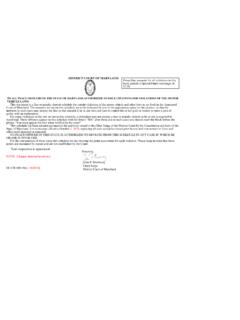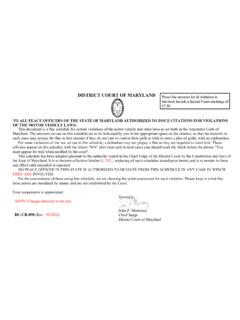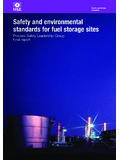Transcription of BASIC theory of driving - Singapore Police Force
1 9th EditionBASIC theory of driving ThE offICIAl hAndBook Published online by Traffic PoliceBASIC theory OF DRIVING1 BASIC theory OF DRIVINGTHE OFFICIAL HANDBOOK9th Edition CONTENTSPART IDRIVING LICENCES Introduction 4 What Is A driving Licence? 4 Fitness To Drive 4 Classes Of driving Licences 4 Test Of Competence To Drive 5 Provisional driving Licence (PDL) 6 Validity Of driving Licence 7 NEW Drivers 7 Driver Improvement Points System (DIPS) 8 Medical Examination 12 Online Portals 12 PART IISIGNS AND SIGNALSM andatory Signs 13 Prohibitory Signs 15 Warning Signs 18 Regulatory Signs 23 Information Signs 25 Pedestrian Crossing Signs 28 Traffic Signs For Tunnels 29 Signs For Pedal-Cycles 30 Directional Signs 31 Expressway Monitoring And Advisory System (EMAS) 33 BASIC theory of driving (Ninth Edition) is published by Singapore Traffic part of this publication may be reproduced, stored in a retrieval system, or transmitted in any form or by any means, electronic, mechanical, photocopying, recording or otherwise, without the prior permission of the publisher.
2 Singapore Traffic Police10 Ubi Avenue 3 Singapore 408865T (65) 6547 0000F (65) 6547 4900 Published online by Traffic PolicePublished on : The information contained in this handbook is accurate at the time of publication. Candidates are advised to log in to the TP website at & LTA website at for the latest theory OF DRIVING2 CONTENTSEMAS Signs 35 Parking in URA/HDB Car Parks 37 Facility Signs 41 Vehicle Markings 41 Common Road Markings 42 Direction Arrows 50 Merging Arrow Markings 50 Signals (Traffic Lights) 51 Signals (On The Road) 53 Signals Given By A Police Officer 54 Hand Signals 56 PART IIITRAFFIC RULES AND REGULATIONSThe Keep-Left Rule 57 Lane Discipline 57 Overtaking 58 Road-Hogging 60 Speed Limits 60 The Give Way Rule At Road Junctions 60 Roundabouts 63 Yellow-Box Junctions 64U-Turns 66 Stopping And Parking 66 Seat Belts 68 Lights 68 Alcohol 69 Light Goods Vehicles 70 Height Limits 70 Use Of Mobile Telephone While driving 71 PART IVCODE OF CONDUCT ON THE ROADM oving Off 72 Mirrors And Signals 72 driving Along 72 Tailgating 72 Safe Following Distance 73 The Two-Second Rule 73
3 Stopping Distance 74 Reversing 74 BASIC theory OF DRIVING3 Safety Of Pedestrians 75 Emergency Vehicles 75 General Safe driving 76 Safe driving Technique (Defensive driving Technique) 79 Stopping And Moving Off At Traffic Light Junctions 86 Roadworthiness 87 PART VPARTS AND CONTROLS OF A CARF ront View/Rear View 88 The Instrument Panel (Dashboard) 89 Names Of Various driving Controls 89 PART VIWORK ZONESRoad Users At Work Zones 90 Work Zone Signs 90 PART VIIDRIVING IN SCHOOL ZONESS chool Zone Safety 92 Traffic Safety Measures 92 driving In School Zones 92 PART VIIIDRIVING IN TUNNELSD aily driving Rules 93 Lane Use And Variable Message Signs (LUS) 94 Emergency Facilities 95 Emergency/Incident Procedures 96 PART IXSECURITY MEASURES TO PREVENT THEFTOF/ FROM MOTOR VEHICLESI ntroduction 98 Motorcycles 98 Cars 99 General 99 PART XKEY POINTS OF THE MOTOR CLAIMS FRAMEWORK (MCF) 100 CONTENTSPART IDRIVING LICENCESBASIC theory OF DRIVING4 INTRODUCTIONThe BASIC theory of driving handbook is essential reading for all road users in Singapore , which comprise the pedestrians, cyclists, motorcyclists and drivers.
4 It covers The Highway Code, which includes the traffic rules, traffic regulations, traffic signs and signals, and it aims to educate and promote road safety for the road users. Many of the rules and regulations in the Code are legal requirements, and if you disobey them, you are committing a traffic offence. You may be fined and given demerit points on your driving licence, which may lead to suspension or revocation of your driving licence, or you may be disqualified by the Courts from driving . Knowing and applying the traffic rules and regulations in The Highway Code could significantly help to reduce road accidents, casualties and fatalities on our roads. WHAT IS A driving LICENCE?1 A driving licence is a legal document issued by the Traffic Police under the Road Traffic Act, which identifies the licensee, sets out the class(es) of vehicle(s) which he/she may legally drive and states such restrictions or conditions as may apply as well as the period for which the licence is valid, where TO DRIVE2 In order to qualify for a driving licence to drive or ride a motor vehicle on the roads in Singapore , an applicant:(a) Must be at least 18 years old;(b) Must have passed the test of competence to drive; (c) Must not be suffering from mental disorder; (d) Must not be suffering from epilepsy; (e) Must not be liable to sudden attacks of disabling giddiness or fainting.
5 (f) Must be able to read at a distance of 25 metres (with the aid of glasses, if worn) a series of 6 letters and figures in white on a black background of the same size and arrangement as those prescribed for the identification mark of a motor vehicle; and (g) Must be able to distinguish the colours red, amber and green from a distance of 25 metres. CLASSES OF driving LICENCES3 The following table is a list of classes of driving licence granted by the Traffic Police under the or those suffering from some physical defect or disability who are 18 years old and carriage of unladen weight not exceeding 250 kg and which are specially designed and constructed, and not merely adapted, for the use of persons suffering from some physical defect or disability and are used solely by those 1 PART IDRIVING LICENCESBASIC theory OF DRIVING5 TEST OF COMPETENCE TO DRIVE4 An applicant for a new class of licence must pass the test of competence to drive, which includes the theory and/or practical driving /riding tests: (a) BASIC theory Test (BTT)The BASIC theory Test (BTT) is designed to test your knowledge of the traffic rules, traffic regulations, traffic signs and signals as well as general road safety.
6 The testing curriculum for BTT is broadly covered in the handbook titled The Official Handbook - BASIC theory of driving and all learner drivers and riders must obtain a pass for BTT before they can proceed to take the advanced theory test the Final theory Test (FTT) or the Riding theory Test (RTT).Be at least 18 years old. Be in possession of a class 2B Qualified Licence for at least one in possession of a class 2A Qualified Licence for at least one at least 18 years old. Be at least 18 years Permit and S-pass holders only need to pass the BASIC theory Test to convert their foreign driving license to be allowed to drive all Class 3 vehicles except for light goods vehicles, mini vans and small Class 3CA licence is introduced to new drivers who only want to drive automated Class 3C at least 21 years old and in possession of a class 3 Qualified at least 21 years old and in possession of a class 3 Qualified at least 21 years old and in possession of a class 4 Qualified cycles with an engine capacity not exceeding 200 , or motor cycles which are propelled by electric motors and registered as cycles with an engine capacity between 201 and 400 cycle with an engine capacity exceeding 400 cars of an unladen weight not exceeding 3000 kg with not more than 7 passengers, exclusive of the driver.
7 And motor tractors / vehicles of unladen weight not exceeding 2500 cars without clutch pedals (auto) of an unladen weight not exceeding 3000 kg with not more than 7 passengers, exclusive of the driver; and motor tractors / vehicles without clutch pedals of unladen weight not exceeding 2500 cars constructed solely and adapted to carry not more than 7 passengers (exclusive of the driver) and the weight of which unladen does not exceed 3000 kg cars without clutch pedals of unladen weight not exceeding 3000 kg with not more than 7 passengers exclusive of the - For public service vehicles which are used on scheduled services and in which passengers are charged separate and distinct motor cars of an unladen weight exceeding 2500 kg and constructed to carry a load or passengers; and motor tractors of an unladen weight between 2500 kg and 7250 vehicle of an unladen weight exceeding 7250 kg and not constructed to carry any Of driving Licences / Test Of Competence To DriveClass 2 BClass 2 AClass 2 Class 3 Class 3 AClass 3 CClass 3 CAClass 4 AClass 4 Class 5 PART IDRIVING LICENCESBASIC theory OF DRIVING6 (b) Final theory Test (FTT)After passing the BTT, and if you want to obtain a motorcar driving licence (Class 3 or 3A), you must pass your FTT before you can take the Practical driving Test.
8 The FTT aims to test your knowledge on driving safety aspects and proper techniques of driving , as well as your interaction with other road users whilst driving on the roads. After you have passed your FTT, you are required to pass the Practical driving Test within two years, failing which, you will have to retake and pass your FTT again before you can apply for another Practical driving Test. The testing curriculum for FTT is broadly covered in the handbook titled The Official Handbook - Final theory of driving . (c) Riding theory Test (RTT)After passing the BTT, and if you want to obtain a motorcycle driving licence (Class 2B), you must pass your RTT before you can take the Practical Riding Test. The RTT aims to test your knowledge on riding safety aspects and proper techniques of riding, as well as your interaction with other road users whilst riding on the roads. After you have passed your RTT, you are required to pass the Practical Riding Test within one year, failing which, you have to retake and pass your RTT again before you can apply for another Practical Riding Test.
9 (d) Practical driving / Riding TestThe Practical driving / Riding Test will be conducted by a driving Examiner appointed by the Traffic Police . You must provide a motor vehicle which is suitable for the test, in good mechanical condition and properly insured against third-party In order to book and take a theory or practical driving / riding test, an applicant must fulfil the following eligibility requirements at the date of booking or date of taking his/her test: (a) He/She has not accumulated more than 12 demerit points; (b) He/She is not under suspension or Court disqualification or is not within the period of one year from the date of revocation of his/her driving licence; (c) He/She is not under Police investigation; and (d) He/She has not committed 2 or more offences of failing to display a distinguishing mark ( Probation Plate) during his/her period of probation as a new driver for his/her other new class of driving driving LICENCE (PDL) 6 After passing your BTT, you may apply for a Provisional driving Licence (PDL) to start learning to drive or ride on the roads with your driving instructor.
10 A PDL is valid for 6 months from the date of grant and can be renewed subsequently for every 6 months. 7 As a PDL holder, you must display two 18 cm square L plates, in a conspicuous position on both the front and back of your motor vehicle during your driving lessons and driving tests, as well as be insured against third-party risk, during your driving tests and driving lessons. You can only drive whilst under the supervision of your licensed driving instructor or driving school s driving instructor. Test Of Competence To Drive /Provisional driving Licence (PDL)PART IDRIVING LICENCESBASIC theory OF DRIVING78 To apply for a PDL, an applicant must fulfil the following eligibility requirements at the date of the application:(a) He/She has not accumulated more than 12 demerit points;(b) He/She has passed his/her BTT;(c) He/She must be able to read at a distance of 25 metres (with the aid of glasses, if worn) a series of 6 letters and figures in white on a black background of the same size and arrangement as those prescribed for the identification mark of a motor vehicle; and(d) He/She must be able to distinguish the colours red, amber and green from a distance of 25 OF driving LICENCE 9 If you are a Singapore Citizen or a Permanent Resident, your driving licence will be valid for your lifetime.






